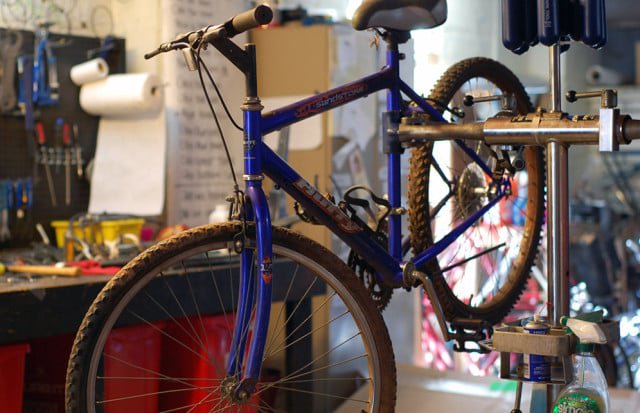7 Things Your Mechanic Knows About You Within 5 Minutes
There’s not much you can hide from your wrench.
There’s not much you can hide from your wrench. – By Whit Yost
“When a customer brings a bike into the shop, I can learn a lot about both the bike and the rider in only a minute or two,” says John Sessa, a service manager at a bike store. “The first thing I’m looking for is a smiling face. If the last ride ended with a crash or a mechanical, then both the bike and the customer might be in bad shape.”
“A quick glance at a customer’s bicycle can be very telling. A saddle that’s level to the ground, handlebars rotated into a good position, and cables and housing cut to an appropriate length is a sign that quality work has been done to the bike in the past. But if the setup is wacky, then it’s likely there will be other not-so-obvious problems that should be addressed.”
Here’s what a seasoned bike mechanic is likely to find out during an initial inspection:
1. Your washing and lubing habits
“I can often tell what brand of chain lube a customer uses (if any) based on the amount of goop on the chain and what it smells like,” says Sessa. While our experts don’t have allegiances to any one brand, both suggest washing your bike regularly then lubing it afterwards – just make sure you wipe off any excess. Extra lube attracts dirt and can do more harm than good if it gunks up your drivetrain.
2. Where you ride
“If a bike spends a lot of time on an indoor trainer, the rear tire is usually squared-off from contact with the roller,” explains Sessa. And since riding indoors produces a lot of sweat, a trainer bike is more likely to have a lot of corrosion – and possibly a seized front derailleur. If you have a dedicated trainer bike, you still need to wash and lube it.
3. Your favourite gears
Believe it or not, this is one case in which a dirty drivetrain can be a good thing, as it can help an experienced mechanic determine which gears you use the most. The mechanic can tell if you’re a “gear masher” by looking at the wear of the teeth on your large chainring and smallest cassette cog. “I can also see which cogs are most worn on the cassette,” Sessa says, “which can be helpful if the customer is looking to change gearing.”
4. You need new cleats
The wear on the pedal where it interfaces with the cleat can be a good indicator of how often a rider changes cleats. It’s easy to forget to replace your cleats regularly, but failing to do so can lead to problems with how your cleat engages with or releases from the pedal. Even without your shoes, a mechanic might be able to tell if you’re ready for a cleat replacement just by looking at the pedal itself.
5. You need a bike fit
Your handlebar tape tells a lot about where you feel most comfortable putting your hands while riding, which can indicate whether your stem is too long or too short. The position of your saddle is another giveaway: A saddle that’s slammed forward on the seatpost could be a sign of back problems, while a saddle with the nose tipped upward or downward might mean a rider is having issues “down there.” In both cases, your mechanic might recommend scheduling a fit session to dial in your position.
6. You’re afraid of your front brake
Bush cites “fear of the front brake” as one of the first things he notices when a bike comes into his shop. If your brake pads or rims are worn unevenly or one brake lever feels mushier than the other, it could be a sign of uneven brake usage. Work on evenly applying your brakes simultaneously and learning how to “feather” your front brake so as not to lock up your front wheel. The front brake offers more stopping power than the rear; once you’ve mastered it, you’ll descend and corner with more confidence.
7. You’re not getting the most out of your suspension
Poorly-tuned suspension is a common occurrence among mountain bikers, and it’s easy to diagnose. Front and rear shocks typically have a rubber ring that indicates the full extent of the shock’s travel. “I often see these rings stop well before the end of the stroke,” Bush says, “meaning that the customer is not taking full advantage of the bike’s suspension.” By adjusting your bike’s suspension relative to your weight, your mechanic can help you squeeze every bit of travel and damping out of the bike, maximising its ability to do what it’s designed to do – go fast.
READ MORE ON: bike advice maintenance


